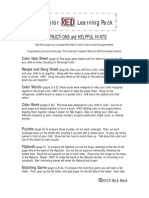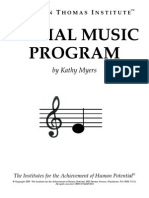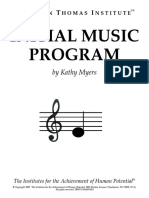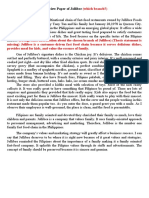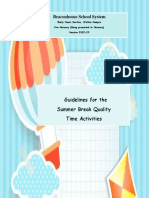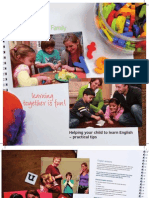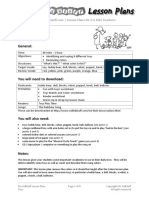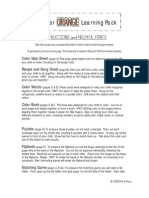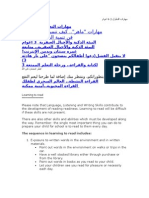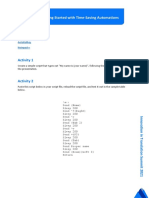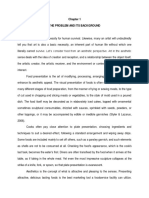Happy Street How To Use DVD
Happy Street How To Use DVD
Uploaded by
Natasa BudisinCopyright:
Available Formats
Happy Street How To Use DVD
Happy Street How To Use DVD
Uploaded by
Natasa BudisinOriginal Description:
Original Title
Copyright
Available Formats
Share this document
Did you find this document useful?
Is this content inappropriate?
Copyright:
Available Formats
Happy Street How To Use DVD
Happy Street How To Use DVD
Uploaded by
Natasa BudisinCopyright:
Available Formats
1
Happy House and Street DVD worksheets teaching notes by Kirstie Grainger
How to use the DVD and worksheets
These worksheets are designed for use alongside the Happy House and Happy Street DVD. Here are some tips and suggestions on how to use the DVD and the worksheets with your class. Things to remember: Always let children become familiar with the relevant section of the DVD before asking them to do activities on the worksheet. Be prepared to play the DVD several times to allow children to become familiar with it. Pause it where necessary to talk about or explain things that happen or words that children dont understand. Use the DVD as a resource to enable children to learn about British culture. Encourage them to be observant. Give them plenty of opportunities to comment on ways in which the lives of the children on the DVD are different or similar to their own. Avoid asking children to complete worksheet activities while watching the DVD; trying to look at two things at once is difficult and can be stressful. Where children are asked to tick or number photos taken from the DVD, you can help them by pausing the DVD in the appropriate places. In this situation, let them spend plenty of time looking at the worksheet before doing the activity.
Some ideas to try when playing a section of the DVD for the first time: Give the children a single question to answer while they watch. This should be something very simple that helps them to understand the gist of the DVD, such as What toy is she singing about? or Where do the children go? or What are the children having for lunch? Dont ask a question that requires them to watch or listen carefully to details. Play the DVD with the sound turned off. Ask the children what they think is happening and what the people on the DVD are talking about. Let the children listen to the DVD without watching (you could cover the screen with a piece of paper). Ask the children what they think is happening or where the children are.
Some ideas for further exploitation of a section of the DVD when children have already watched and listened several times: Play the DVD section with the sound turned off. See if children can remember any of the dialogue. Use the DVD to focus on language that you want the children to practise. Pause it and ask the children to repeat parts of the dialogue. You could do this with the subtitles turned on or off.
Happy House and Happy Street DVD teaching notes Oxford University Press 2012
2 Ask the children to watch and listen for particular words or phrases. You could ask the children to shout out a particular word when they hear it. Let the children listen to a section of the DVD without watching (you could cover the screen with a piece of paper). Let them work in groups, each person in the group taking the part of one of the people on the DVD. Ask them to mime what is happening on the DVD.
Teaching notes for the worksheet activities
Please see page 1 of these notes for some different ways of watching and using the DVD before the children do the activities on the worksheets. Happy House 1 In the classroom Watch, read and match. Watch the DVD. Tell the children to match the names to the people. Practise saying the names. Answers: 1st picture = Lizzy 2nd picture = Mrs Bell 3rd picture = Joe Follow and trace. Watch and tick (! ). Ask the children to look at the objects on the table in the picture. Say the words and let them point to the objects. Tell the children to follow the lines and trace the words. Ask the children which of the objects they saw on the DVD. Watch the DVD again. Pause it each time one of the classroom objects is shown, and ask the children to call out the word. Tell them to tick the box next to the objects they see. Answers: Book, pencil case and pencil are all seen and mentioned on the DVD. Happy House 1 Ten little teddy bears Find, colour and count. Say or sing. Watch the DVD. Encourage the children to sing along with the song. Ask the children to colour all the teddy bears in the picture. They should use the same colour for all the teddy bears, e.g. brown. Make sure they understand that they should colour pictures of teddy bears as well as actual teddy bears. (There are pictures of teddy bears on the bed cover, on the lamp and in the book.) Tell the children to count the teddy bears. Ask How many teddy bears? (ten). Say or sing the song again. You could ask the children to point to the teddy bears as they sing. Colour, count and write. Ask again How many teddy bears? Tell the children to write 10 in the box under the picture of the teddy bear. They should colour the teddy bear the same colour as they used for the teddy bears in the big picture above. Now ask the children to count the kite, then to colour the kites in the big picture the same colour. Ask How many kites? (four). Do the same with the ball and the bike. Answers: Happy House and Happy Street DVD teaching notes Oxford University Press 2012
3 There are 10 teddy bears, 4 kites, 6 balls and 3 bikes.
Happy House 1 At a toy shop Watch and number. Watch the DVD. Look at the photos with the children. Ask them what toys they can see (a guitar, a car and a doll). Ask the children if they can remember in what order they saw the toys on the DVD. Watch again so they can check and number the boxes. Answers: guitar = 2 car = 3 doll = 1 Follow and trace. Draw your favourite toy. Say. Hold up your copy of the worksheet and point to the photo of Joe. Say This is my favourite toy and follow the line with your finger to the car. Ask Whats his favourite toy? Read the words with them: Its a car. Do the same with the girl. Point to the blank face at the bottom and say This is you. This is your favourite toy and follow the line with your finger to the empty box. Ask several children individually Whats your favourite toy? and encourage them to answer you in English if they know the word. Tell the children to draw themselves and their favourite toy. While they are working, take the opportunity to talk to some of the children. Encourage them to say to you This is my favourite toy. Its a ... Happy House 1 Ive got a kite Watch and order. Watch the DVD. Look at the photos with the children. Ask them what things they can see in the photos (a bag, a kite, a ball, and a pencil case and coloured pencils). Ask the children if they can remember in what order they saw the objects on the DVD. Watch again so they can check and number the boxes. Pause the DVD as necessary. Answers: bag = 3 kite = 1 ball = 2 pencil case and coloured pencils = 4 Colour and say. Tell the children to colour the ten pencils, using ten different colours. While they are working, take the opportunity to talk to some of the children. Point to a pencil and ask What colours this? You could also ask What colour is number (three)? Happy House 1 The Hokey Cokey Cut and order. This is a popular song in the UK, and is often sung at parties and other events for children. Watch the DVD. Encourage the children to sing along with the song. Play the DVD again and do the actions with the children.
Happy House and Happy Street DVD teaching notes Oxford University Press 2012
4 Tell the children to cut out the photos and to try to put them in order. Note that they will need to know the song quite well in order to do this. Play the DVD again so they can check they have got the order correct. You might like to cover the screen while they do this, as it will encourage them to focus on the song.
Answers: The correct order is: f, e, a, d, c, b. Happy House 1 Oh, Christmas tree! Colour and cut. Fold and stick. Watch the DVD. Encourage the children to sing along with the song. If possible, photocopy this worksheet onto white card rather than paper. Look at the page with the children. Tell them that they are going to make a stand-up Christmas tree, like the one at the bottom of the page. Look at the two Christmas tree pictures. Ask the children to decorate and colour them so that one of them looks like an indoor Christmas tree, and the other looks like a tree outside, with snow on its branches. They can also colour the backgrounds, drawing appropriate details if they wish to indicate indoor and outdoor scenes. Explain that they are going to cut along the dotted lines, and fold along the grey lines (show them the key at the right side of the page). Tell the children to trace round the cut lines with their finger, then to cut along them. They will end up with two rectangles. Tell them not to cut along the short lines at the bottom of the tree pictures until later. Tell them to fold the big rectangle so that the trees are on the outside. Hand out glue so children can stick the two halves together. Finally, they should carefully cut the slit at the bottom of the tree picture, and slot the small rectangle into the slit so that the tree stands up. When the children have completed their trees, you could display them in the classroom. Sing the song again while they look at each others trees!
Happy House 2 At the zoo Read. Watch and write the number. Watch the DVD. Ask the children what animals they saw on the DVD. You might like to watch it again, pausing each time an animal appears. See how many of the animals the children can name (either in their own language or in English). Read the words in the speech bubbles with the children. Ask them if they can remember who says each sentence. Play the DVD again so they can check and write the numbers. Answers: a4 b1 c3 d2
Find and write Yes or No. Colour. Look at the picture with the children. Say the numbers and ask them to name the animals. Teach the words giraffe, elephant and parrot if the children dont know them. (Or if you dont want to teach the word parrot, you could use the word bird for this activity). Say Point to number 5. When the children have found number 5, ask Is it a tiger? The children answer No. Say Is it a monkey? (No). Ask What is it? (Its a snake). Repeat with some or all of the remaining animals. Happy House and Happy Street DVD teaching notes Oxford University Press 2012
5 Now tell the children to read the questions, finding each appropriate animal in the picture, and answer Yes or No. Finally they should read the colours and colour the animals in the appropriate colours. While they are working, take the opportunity to talk to some of the children. Ask Whats this? and What colour is it?
Answers: 1 yes 2 no 3 no 4 yes 5 yes Happy House 2 I dont like milk Watch and match. Watch the DVD. Ask the children if they can remember what Ben and Jessica like and dont like. Play the DVD again so they can check. Then ask them to draw lines matching each food to the smiley or sad face, as appropriate. Now your turn. Match and say. Hold up your copy of the worksheet. Point to each food in turn and say sentences about yourself, e.g. I dont like pizza. I like cheese, etc. Now tell the children to do the same, in pairs. Finally they draw lines from each food to the smiley or sad face, to show whether or not they like it. Happy House 2 This is the way ... Watch and order. Watch the DVD. Encourage the children to sing along with the song. Look at the photos with the children. Ask them to tell you in their own language what the children are doing (and encourage them to tell you any English words they know). Ask the children if they can remember in what order they saw these actions on the DVD. Watch again so they can check and number the boxes. Play the DVD again, covering the screen to encourage children to focus on the song. Let them sing the song again, using the pictures on the worksheet as a prompt for the actions. Answers: 1st picture (This is the way we clean our teeth ...) = 3 2nd picture (This is the way we go to school ...) = 4 3rd picture (This is the way we wash our face ...) = 1 4th picture (This is the way we brush our hair ...) = 2 Match and write. Hold up your copy of the worksheet and point to the picture of a girl brushing her hair. Ask Where is she? Say Shes in the bedroom. Show the children with your finger how to draw a line from the girl to the picture of the bedroom. Tell the children to match each of the remaining pictures on the left hand side to the correct room by drawing a line. Now ask the children to write the name of each room next to the appropriate picture. Answers: 1 (girl brushing hair) matched to 3rd room (bedroom) 2 (boy brushing teeth) matched to 2nd room (bathroom) Happy House and Happy Street DVD teaching notes Oxford University Press 2012
6 3 (girl watching TV) matched to 1st room (sitting room) 4 (boy eating breakfast) matched to 4th room (kitchen)
Happy House 2 Two little eyes Watch. Circle the foods you see. Watch the DVD. Revise the words eyes, ears, nose and mouth. Play the DVD again, covering the screen to encourage children to focus on the song. Encourage them to join in with the song and the actions. Ask the children what foods they remember seeing on the DVD. Play it again, with the screen uncovered, and ask them to call out the food words. Finally they should circle the foods they saw. You might want to play the DVD again so they can check. Answers: The foods shown on the DVD are: apples, bananas and cheese. Trace, order and match. Read the words with the children and tell them to trace them carefully. Now tell the children to order the words in the order in which they hear them in the song. Finally they should draw lines to match each word to the correct face part in the photo. Answers: ears = 2 nose = 3 eyes = 1 mouth = 4
Happy House 2 Ive got blond hair Colour and say. Draw. Watch the DVD. Play the DVD again, pausing it when the first child says Ive got blond hair and blue eyes. Repeat the sentence and ask the children to say it after you. Hold up your copy of the worksheet and point to the first photo. Play the next part of the DVD, pausing it when this boy appears. Listen to what he says, then show the children the words hair and eyes under the picture of the boy. Ask them what colours they should colour these words (hair and eyes should both be brown). Give them a moment to colour the letters of each word. Repeat with the remaining children. Now ask the children to draw their own face and hair, colouring their hair and eyes the correct colours, and to colour the words below with the same colours. Finally let the children show their pictures to each other. Encourage them to say Ive got (brown) hair and (blue) eyes. Answers: a brown hair, brown eyes b blond hair, blue eyes c brown hair, brown eyes Happy House and Happy Street DVD teaching notes Oxford University Press 2012
7 d blond hair, blue eyes Happy House 2 A fashion show Match. Watch and circle the words you hear. Watch the DVD. Hold up your copy of the worksheet, point to the skirt, say the word, and show them with your finger how to draw a line matching the skirt picture to the word skirt. Let the children complete the activity independently. While they are working, take the opportunity to talk to some of the children. Ask them to name the clothes. Ask the children what clothes the children talked about on the DVD. Play the DVD again, pausing where necessary to allow the children to circle the appropriate clothes as they hear the words. Write. Ask the children to complete the text with the clothes words. Play the DVD again if necessary. Happy House 2 The sun has got his hat on Watch and circle. Watch the DVD. Look at the photos. Ask the children which of these scenes appear in the video. Play the DVD again, pausing as necessary so they can circle the photos. Answers: Photos 1, 2 and 4 appear in the DVD. Write. Cut, draw and colour. If possible, show the children some real holiday postcards, preferably ones that have been written on and sent. Look at the picture, the address and the message. Explain that they are going to imagine they are on holiday, and that they are sending a postcard to someone at home. Next tell them to trace the words and complete the message. They should write the name of the person they are writing to on the first line, a weather word on the second line, and their own name on the third line. If you like, you could ask the children to write their address on the lines on the right hand side, although this may be a bit difficult for some children to attempt. Alternatively, they could simply write the name of the person they are sending the postcard to. Finally, they cut out the card and draw a picture of their holiday destination on the back. Happy House 2 Hot cross buns! Watch and circle. Watch the DVD. Encourage the children to sing along with the song. Look at the photos on the worksheet. Ask the children which of the people appeared in the DVD. Play the DVD again so they can check and circle the photos. Answers: The DVD shows Ben, Jessica and their parents (photos 1, 2, 5 and 6). Find and count. Say. Happy House and Happy Street DVD teaching notes Oxford University Press 2012
8 Tell the children to count the Easter eggs in the picture. Explain that there are two types and they should count each type separately. Tell them to write the correct number in each box.
Answers: 1st type: 10 eggs 2nd type: 8 eggs
Happy Street 1 At school Watch and match. Watch the DVD. Look at the pictures and ask the children to name the objects. Ask them if they can remember who had these things on the DVD. Play the DVD again so the children can check. Pause it where necessary to allow them to draw lines matching each object to the correct child. Answers: Girl (Jessica): pencil and pencil case Boy (Jasper): pen and ruler Read and colour. The children read Bens speech bubble and colour the classroom objects. When they have finished, ask them to compare their work with a friend, to check that they have coloured each object the same colour. Happy Street 1 Money in Britain Watch and match. Write. Watch the DVD. Ask the children if they remember how much money each person had at the beginning of the DVD. Say ten pounds and write 10 on the board. Repeat with one pound (1). Replay the part of the DVD where the Ben is counting his money. Count up the coins that he has got and sketch them on the board (two 20p coins, one 5p coin, five 1p coins, and one 50p coin). Tell the children to match each the money to the people. Finally the children write how much money the three people have got altogether. Draw and write the prices. Hold up your copy of the worksheet, point to each photo in turn and read the speech bubbles with the children. Tell the children to draw what each person want to buy, and to write the prices for the first three things on the price tags. You could set up a shop in the classroom and do simple shopping role plays with the children. Answers: The CD is 15, the T-shirt is 10 and the chocolate bar is 70p.
Happy House and Happy Street DVD teaching notes Oxford University Press 2012
9 Happy Street 1 I like pizza Watch and match. Watch the DVD. Look at the photos with the children. See if they can remember which child liked each food on the DVD. Tell them to draw lines, then play the DVD again so they can check. Answers: Ben likes pizza and apples. Jessica likes sandwiches and ice cream. Now your turn. Point and say I like ... or I dont like ... Ask the children to work in pairs. They should take turns to point to a food and say a true sentence about themselves, e.g. I like ice cream or I dont like bananas. Happy Street 1 Where are the people and things? Watch and match. Watch the DVD. Now look at the pictures and read the words on the page. Ask Wheres Jessica? and see if the children can remember where Jessica was on the DVD (in the sitting room). Show the children with your finger where to draw a line (from the word Jessica to the picture of the sitting room). Tell the children to draw a line from each word to the correct room. Finally, the children could ask and answer in pairs, as above. Answers: Jessica sitting room bag sitting room Mum bathroom book bedroom Write and match. Tell the children to complete the dialogue by copying the correct words from the boxes below the activity, and matching the questions and answers. When they have finished, play the DVD again so they can check their answers. Finally, check the answers together. Choose one child to ask the questions, and let him/her choose children to ask. He/She asks Wheres my bag? and points to a classmate, who answers Its on the sofa. Answers: Wheres my bag? Wheres Mum? Wheres my book? Its on the sofa. Shes in the bathroom. Its under the bed.
Happy Street 1 At a big, old house Look. Watch and write. Watch the DVD. Ask the children if they can remember what rooms the children visited (the hall, a bedroom, the dining room). Encourage them to say the words in English.
Happy House and Happy Street DVD teaching notes Oxford University Press 2012
10 Look at the photos on the worksheet. Ask the children which room they think each photo shows. Play the DVD again so they can check. They will need to watch carefully in order to spot the details shown in the pictures. Then ask them to write the words on the lines.
Answers: 1 bedroom 2 hall 3 dining room Look and write. Watch and tick (! ) the things you see. Tell the children to find the things numbered 16 in the picture of the dolls house, and write the correct word on the line next to each number. Now ask them which of these things they saw on the DVD. Play the DVD again, and ask them to call out the name of each object when they see it. Pause the DVD as you find each object to allow them to put a tick in the box. Ask the children to put a cross next to the objects that dont appear on the DVD. Answers: 1 bed 2 cupboard 3 bananas 4 chair 5 table 6 scooter ! ! " ! ! "
Happy Street 1 Hes got green eyes Watch and write B, J or L. Watch and put a tick (! ) or a cross (" ). Write. Watch the DVD. Ask the children if they can remember the questions that the children asked about the man in the photo. Recap on the names of the children on the DVD (Jessica, Ben, Jasper and Leanne). Play the DVD again. Ask the children to listen out for the questions, and to write the correct initial next to each question on the worksheet. Play the DVD again. Ask the children to listen out for the answers (Yes, he has and No, he hasnt). Tell them to put a tick or cross in each box. Now the children write the answers in Jessicas speech bubbles. You could play the game shown on the DVD with your class. Find a picture of a person in a magazine (or draw a picture yourself) and give it to a child without showing it to the rest of the class. Tell the class whether the picture shows a man, woman, girl or boy. Invite the class to ask questions for the child with the picture to answer (e.g. Has she got blond hair?). The children listen to the answers and draw a picture of the person, as on the DVD. Answers: L Has he got short hair? B Has he got brown hair? J Has he got curly hair? L Has he got a beard? (tick) (cross) (tick) (tick) Yes, he has. No, he hasnt. Yes, he has. Yes, he has.
Read and draw. The children read the text and draw a picture of the girl who it describes. Happy Street 1 At the sports centre Happy House and Happy Street DVD teaching notes Oxford University Press 2012
11
Watch and order. Write. Watch the DVD. Look at the photos. Ask the children if they remember seeing these scenes on the DVD. Play the DVD again. Tell the children to say Stop! when they see one of the scenes shown on the worksheet. Pause the DVD to allow them to write the number on the worksheet. The children write each phrase next to the picture that shows that activity (or where the children are talking/reading about that activity). Answers: a (3) play football d (5) ride a horse b (6) play guitar c (1) swim e (4) use a computer f (2) ski
Draw and complete. Tell the children to draw two pictures of themselves. The first picture should show them doing something that they can do well, and the second picture should show them trying to do something that they cant do, or that they find difficult. Some children may be able to do all the things that are listed on the page. You might like to ask them to help you think of things that lots of children cant do. Write a list on the board e.g. juggle, run five kilometres, abseil. Tell the children to complete the sentences. Help with them with any vocabulary they need if they have chosen to draw and write about something that is not on the page. Talk in the childrens own language about the things that they can and cant do. Ask questions, e.g. Is it difficult to learn to do these things? Do they think they will learn to do the things they currently cant do? Will it take a lot of practice? Happy Street 1 Christmas in Britain Watch and tick. Ask the children what they do at Christmas (e.g. eat a special dinner, open presents). Explain that they are going to see some of the things that Ben and Jessica do at Christmas. Watch the DVD. Then recap on the things that they saw the children doing. Use the worksheet to revise vocabulary for special Christmas things in Britain, and present any new words. Ask the children to tell you which things they also have in their country, and which things they dont have. Play the DVD again. Tell the children to say Stop! when they see one of the things on the worksheet. Pause the DVD to allow them to put a tick next to the photo. Answers: All of the items are shown on the DVD apart from the Christmas pudding and the angel. Happy Street 2 Ben and Jessicas day Watch and match. Watch the DVD. Talk about Jessicas day. How is it the same or different from the childrens own routines on school days? The children read the sentences and match each one to the correct clock. Answers: I get up at half past seven. clock c I have breakfast at eight oclock. clock b I go to school at quarter to nine. clock d Happy House and Happy Street DVD teaching notes Oxford University Press 2012
12 I go home at half past three. clock a Ask and answer. Draw the times and write. Practise the question What time do you go to bed? and the answer I go to bed at ... The children ask and answer in pairs. Tell them to draw the times for themselves and one friend on the clocks on the page. Now ask a few children to tell you about their friend e.g. He goes to bed at nine oclock. Remind them if necessary that we say I go but He goes and She goes. The children complete the sentences under the clocks, starting the second sentence with He or She as appropriate. Happy Street 2 Sandwiches for lunch Watch and write. Watch the DVD. Read the questions on the page and ask the children if they can remember what Leanne said in answer to each question. Play the DVD again so the children can check. Then ask them to write Leannes answers. Finally let the children ask and answer in pairs. Answers: 1 Yes, I do. 2 No, I dont. 3 Yes, I do. Now your turn. Choose and write. Tell the children to write each food word next to the appropriate meal (some of the foods might be eaten at more than one of the meals; in that case ask them to choose the meal where they are most likely to eat that food). Ask them to add more food words for each meal. Answers will vary. Happy Street 2 I go to school by car Circle. Watch and check. Watch the DVD. Ask the children what different types of transport they saw on the DVD. Make a list on the board. Ask the children to read the questions on the worksheet, and see if they can answer any of them from memory. Play the DVD again. Tell the children to look for the answers to the questions, but not to do any circling at this stage. Let the children circle the answers, then play the DVD again so they can check and correct any wrong answers. Pause the DVD where necessary. Answers: 1 black 2 red 3 white 4 red and grey 5 park 6 purple 7 red Order and write. Write and draw. Tell the children to order and write the sentences that Mum and Jessica say. Now practise the question How do you go to school? Practise the answers I go to school by car and I walk to school. Ask several children the question, then let the children ask and answer in pairs. Happy House and Happy Street DVD teaching notes Oxford University Press 2012
13 Tell the children to write about themselves and one friend. Help them if necessary with the beginnings of the sentences, making sure they use the correct verb form (e.g. I go ..., I walk ..., He goes ..., She walks ...).
Happy Street 2 Wheres Aunt Janes house? Watch and order. Write. Watch the DVD. Look at the photos. Ask the children if they remember seeing these scenes on the DVD. Play the DVD again. Tell the children to say Stop! when they see one of the scenes shown on the worksheet. Pause the DVD to allow them to write the number on the worksheet. The children write each phrase next to the appropriate picture. Answers: a (6) park d (1) library b (5) school e (4) traffic lights c (2) cinema f (3) train station
Draw and write. Look at the map and point out the familys route (shown with arrows). Ask the children if they can remember what place they started at and what places they walked past (let them refer to the activity above). Play the DVD again and ask the children to follow the route with their fingers. Now tell the children to complete the key in the top right hand corner of the map, copying the relevant place names from the box under the first activity. Finally they should draw the symbols in the appropriate boxes on the map. Pause the DVD at the place where the family are looking at the map, and let the children check that their map is the same. You might like to ask the children to draw maps of routes they take themselves, e.g. from home to school, adding appropriate symbols and a key. Answers: The text in the key should read: train station school swimming pool park The symbols should be drawn on the map as follows: At the top: swimming pool symbol In the big box below the swimming pool symbol: park symbol In the small box to the left of the park symbol: school symbol At the bottom: train station symbol. Happy Street 2 What do you like doing? Watch and order. Watch the DVD. Look at the photos. Ask the children if they remember seeing these scenes on the DVD. Play the DVD again. Tell the children to say Stop! when they see one of the scenes shown on the worksheet. Pause the DVD to allow them to write the number on the worksheet. Answers: a3 b2 c1 d4 Happy House and Happy Street DVD teaching notes Oxford University Press 2012
14 What do they say? Write. The children write the sentences that the children say on the DVD. You might like to ask them to write similar sentences about themselves in their notebooks. Answers: 1 I like listening to music. 2 I like playing computer games. 3 4 I like reading comics. I like riding my bike.
Happy Street 2 A witch came flying Watch and order. Watch the DVD. Encourage the children to join in with the song. Look at the photos. Ask the children if they can remember in which order they saw these children. Play the DVD again so they can check and write the numbers. Answers: a4 b1 c2 d3 Choose and draw. Tell the children to draw themselves in a Halloween costume inside the open door. Let the children show their pictures to each other, saying Im a (witch). Happy Street 2 Bonfire Night (1) Watch and order. Write. Watch the DVD. Look at the photos. Ask the children if they remember seeing these scenes on the DVD. Play the DVD again. Tell the children to say Stop! when they see one of the scenes shown on the worksheet. Pause the DVD to allow them to write the number on the worksheet. The children write each phrase next to the appropriate picture. Answers: a (2) guy d (4) sparkler b (5) firework c (1) Bonfire Night e (6) bonfire f (3) baked potatoes
Write. Then watch and match. Tell the children to order the words in the box below the activity and to write the sentences in the speech bubbles. Check the childrens sentences. Then ask them if they can remember who says each sentence on the DVD. Play the DVD again, pausing as necessary to allow them to match each sentence to the correct picture. Answers: 1 Now, be careful! 2 I love Bonfire Night! 3 Im making baked potatoes. 4 Ooh, sparklers! (Dad) (Ben) (Mum) (Jessica)
Happy House and Happy Street DVD teaching notes Oxford University Press 2012
15 Happy Street 2 Bonfire Night (2) Choose, cut and colour. Stick. Tell the children to choose clothes to complete the guy. They should cut them out and colour them in, then stick them onto a piece of paper. (Note that they will only need to colour the bits that will show when the guy is stuck together!). Happy Street 2 My Dads job Watch and order. Write. Watch the DVD. Look at the photos. Ask the children if they remember seeing these scenes on the DVD. Play the DVD again. Tell the children to say Stop! when they see one of the scenes shown on the worksheet. Pause the DVD to allow them to write the number on the worksheet. The children write each sentence next to the appropriate picture. Answers: a (2) He brushes his teeth. b (4) He checks his mask. c (5) He drinks a cup of tea. d (6) He washes the fire engine. e (1) He has breakfast. f (3) He goes to work. Match. The children match the sentence halves and match each sentence to the correct picture. 1 2 3 4 5 Jessicas dad gets up at half past seven. For breakfast he eats eggs and sausages. He checks the fire engines. After lunch, he goes to schools. He goes home at five oclock. (picture e) (picture c) (picture d) (picture a) (picture b)
Happy Street 2 Whats she doing? Watch and order. Watch the DVD. Look at the photos. Ask the children if they remember seeing these scenes on the DVD. Play the DVD again. Tell the children to say Stop! when they see one of the scenes shown on the worksheet. Pause the DVD to allow them to write the number on the worksheet. The children tick the appropriate word under each picture. Answers: a (6) eating d (3) drinking b (5) writing e (2) talking c (1) walking f (4) reading
Look at the pictures and write. The children write the appropriate sentence on each line (the numbers correspond to the numbers that they wrote in the first activity). Answers: 1 Shes walking. 4 Shes reading.
Happy House and Happy Street DVD teaching notes Oxford University Press 2012
16 2 Shes talking. 3 Shes drinking. 5 Shes writing. 6 Shes eating.
Happy Street 2 A Christmas song Watch and circle. Watch the DVD. Encourage the children to join in with the song. Look at the photos and see if the children can name any of the objects. Explain that it is common in Britain for people to put wreaths made of holly (and other evergreen leaves) on their front doors. Ask the children which of these objects they saw on the DVD. Play the DVD so they can check and circle the objects. Pause the DVD where necessary. Answers: The DVD shows a Christmas tree, a wreath and several hats. Draw yourself and sing. Children draw themselves in the carol-singing scene and colour the whole picture. Play the song on the DVD while the children are working. Encourage them to sing along.
Happy House and Happy Street DVD teaching notes Oxford University Press 2012
You might also like
- The Color Red Learning PackDocument15 pagesThe Color Red Learning Packamarierives100% (1)
- Greenman+Teacher's+Book+sample+unit WebDocument14 pagesGreenman+Teacher's+Book+sample+unit WebFranJaVierNo ratings yet
- Initial Music Program: by Kathy MyersDocument59 pagesInitial Music Program: by Kathy MyersLetícia Azevedo Pozzer100% (2)
- I M ProgramDocument59 pagesI M ProgramAkhila Basu100% (1)
- Oxford Reading Tree Lesson Plan, Lesson 15 The Gulls' PicnicDocument4 pagesOxford Reading Tree Lesson Plan, Lesson 15 The Gulls' PicnicSix minutes0% (1)
- Brad McDonaldDocument6 pagesBrad McDonaldAndrew Paul LynesNo ratings yet
- A Review Paper of Jollibee: (Which Branch?)Document1 pageA Review Paper of Jollibee: (Which Branch?)Rheyceelyn VillavirayNo ratings yet
- 3 Dreamland Margate SC Dreamland Business PlanDocument171 pages3 Dreamland Margate SC Dreamland Business PlanrajawaqasNo ratings yet
- C.O.T DLP 4thDocument7 pagesC.O.T DLP 4thEl-el Galindo MascariňasNo ratings yet
- Cookie's Three in A Tree - Stories & Songs DVD-ROM - Songs - Teacher's NotesDocument27 pagesCookie's Three in A Tree - Stories & Songs DVD-ROM - Songs - Teacher's NotesMaryp Pl TraversNo ratings yet
- Hello, How Are You?: Lesson 1Document28 pagesHello, How Are You?: Lesson 1Korosh CheginiNo ratings yet
- TR 1.4.3 EEE Model SequencingDocument8 pagesTR 1.4.3 EEE Model SequencingIesya NimNo ratings yet
- Summer Break HW Guidelines For Pre NurseryDocument7 pagesSummer Break HW Guidelines For Pre Nurserysheraz100% (1)
- Parents Booklets Practical Tips EnglishDocument9 pagesParents Booklets Practical Tips EnglishNovrizal SyahNo ratings yet
- UKG Holiday Homework 24-25 UKG BDocument36 pagesUKG Holiday Homework 24-25 UKG BAbdul RashidNo ratings yet
- Literacy Development From Birth To Age ThreeDocument26 pagesLiteracy Development From Birth To Age ThreekarmavisionNo ratings yet
- TB StarterA Unit6Document12 pagesTB StarterA Unit6Enzo SosaNo ratings yet
- Preschool Lesson Themes and ESL Activities: 1. GreetingsDocument6 pagesPreschool Lesson Themes and ESL Activities: 1. GreetingsNguyen HalohaloNo ratings yet
- In The Garden: Presentation and Pre-Reading (Page 16)Document2 pagesIn The Garden: Presentation and Pre-Reading (Page 16)lleizaloNo ratings yet
- Sound Foundation For Babies - Week 1Document5 pagesSound Foundation For Babies - Week 1CochlearIndiaNo ratings yet
- Hello 2Document2 pagesHello 2salma salloukiNo ratings yet
- FPK HandbookDocument8 pagesFPK HandbookGenesis De Vera DiocaresNo ratings yet
- week-13-learning-project-y2Document3 pagesweek-13-learning-project-y2Shakthi saiNo ratings yet
- Class Nursery - Summer Holidays Homework 2023 (A)Document48 pagesClass Nursery - Summer Holidays Homework 2023 (A)YaqubNo ratings yet
- Scan Third 2Document25 pagesScan Third 2Diego SolanoNo ratings yet
- Planning Remedial and Enrichment ActivitiesDocument42 pagesPlanning Remedial and Enrichment ActivitiesOmy100% (11)
- FREEParent Home PackDocument38 pagesFREEParent Home PackJanette MendezNo ratings yet
- Elemwin13cal1 1Document2 pagesElemwin13cal1 1api-32541207No ratings yet
- What Should Your 3-5 Year Olds Should DoDocument22 pagesWhat Should Your 3-5 Year Olds Should DoTejaswini RastogiNo ratings yet
- Effective Parenting - Literacy May - 06Document13 pagesEffective Parenting - Literacy May - 06stevenerrolNo ratings yet
- Grandparenting - Play With Me! Activities That Make Learning Fun 24 To 36 MonthsDocument3 pagesGrandparenting - Play With Me! Activities That Make Learning Fun 24 To 36 MonthsAmna ArshadNo ratings yet
- Very Young LearnersDocument5 pagesVery Young LearnersAntoni SkrzypczykNo ratings yet
- Activities For Promoting EarlyLiteracyDocument28 pagesActivities For Promoting EarlyLiteracyrgibson26No ratings yet
- 01 Final Math Lesson Plans For NURSERYDocument41 pages01 Final Math Lesson Plans For NURSERYAsad Writes officialNo ratings yet
- jazz-giant-activity-guideDocument3 pagesjazz-giant-activity-guidePlamenNo ratings yet
- Patch 1 Teaching NotesDocument18 pagesPatch 1 Teaching NotesBeaty Caro LeonaNo ratings yet
- The Toy LessonDocument8 pagesThe Toy LessonFolahanmi AyoNo ratings yet
- At The Museum: Comprehension (Page 21)Document3 pagesAt The Museum: Comprehension (Page 21)testosOSNo ratings yet
- Read-Alouds Build Readers: KID BitsDocument2 pagesRead-Alouds Build Readers: KID BitsAnonymous GAU7ZZ5100% (1)
- BF Active English L1 FDocument45 pagesBF Active English L1 FSole BarriaNo ratings yet
- Module 4Document24 pagesModule 4riki rikoNo ratings yet
- Getting Ready For SchoolDocument116 pagesGetting Ready For SchoolDipu ShakyaNo ratings yet
- year-one-week-13-home-learningDocument3 pagesyear-one-week-13-home-learningShakthi saiNo ratings yet
- The Color Orange Learning PackDocument15 pagesThe Color Orange Learning Packamarierives100% (1)
- Activities To Try at HomeDocument2 pagesActivities To Try at HomeCatalina NicaNo ratings yet
- Auditory Processing ExercisesDocument7 pagesAuditory Processing ExercisesRaghaveni RVNo ratings yet
- G5 Selective LessonPlan Unit7Document24 pagesG5 Selective LessonPlan Unit7Nguyễn Tuấn ĐịnhNo ratings yet
- Ort BCK Stream TnsDocument2 pagesOrt BCK Stream TnsAlmira AslamNo ratings yet
- Unite 2 QuizDocument4 pagesUnite 2 Quiztetianalyt171No ratings yet
- Tips For Families ColorDocument6 pagesTips For Families ColormasterofwolvesNo ratings yet
- G5 Selective LessonPlan Unit12Document27 pagesG5 Selective LessonPlan Unit12Hai Đỗ ThịNo ratings yet
- Second Grade - First Day LessonDocument2 pagesSecond Grade - First Day LessonDiana FoxNo ratings yet
- Communication Milestones 4 To 5 YearsDocument2 pagesCommunication Milestones 4 To 5 YearsAya AbouseifNo ratings yet
- Routines and Classroom Management For (Very)Document24 pagesRoutines and Classroom Management For (Very)Patricia Andreea LogaNo ratings yet
- Game Bank For Young English StartersDocument29 pagesGame Bank For Young English StartersThùy Duyên Mai100% (1)
- Teaching Kids Free Time With Primary Students Lesson PlanDocument3 pagesTeaching Kids Free Time With Primary Students Lesson PlanNgan DoanNo ratings yet
- Summer Holiday Homework - PSDocument35 pagesSummer Holiday Homework - PSschhabra24No ratings yet
- Toddler Handouts Part Two Language CoachingDocument8 pagesToddler Handouts Part Two Language CoachingHolly Maria CassonNo ratings yet
- 3 and 4 Year Old SequnceDocument73 pages3 and 4 Year Old Sequnceibrahim100% (3)
- Ukg Holiday Homework 2023-24Document8 pagesUkg Holiday Homework 2023-24laarchplan pvtltdNo ratings yet
- Sparks 2 TB-2Document32 pagesSparks 2 TB-2jarp2No ratings yet
- N Reisi (Songs) FDocument15 pagesN Reisi (Songs) Fjemme0eNo ratings yet
- Lesson Plan SixDocument6 pagesLesson Plan Sixapi-253502126100% (1)
- DW!Document2 pagesDW!Natasa BudisinNo ratings yet
- RecepticiDocument39 pagesRecepticiNatasa BudisinNo ratings yet
- Europass Curriculum Vitae: Personal InformationDocument2 pagesEuropass Curriculum Vitae: Personal InformationNatasa BudisinNo ratings yet
- 2021 Innovation in Translation Summit - Nora Díaz - WorksheetDocument3 pages2021 Innovation in Translation Summit - Nora Díaz - WorksheetNatasa BudisinNo ratings yet
- Saruna Skyline Cenovnik SRB OPTIMDocument16 pagesSaruna Skyline Cenovnik SRB OPTIMNatasa BudisinNo ratings yet
- Europass Curriculum Vitae: Personal InformationDocument2 pagesEuropass Curriculum Vitae: Personal InformationNatasa BudisinNo ratings yet
- PELDA Multido TablazatDocument8 pagesPELDA Multido TablazatNatasa BudisinNo ratings yet
- Last of The Burrnesha: Balkan Women Who Pledged Celibacy To Live As MenDocument3 pagesLast of The Burrnesha: Balkan Women Who Pledged Celibacy To Live As MenNatasa BudisinNo ratings yet
- PELDA TartalomjegyzekDocument4 pagesPELDA TartalomjegyzekNatasa BudisinNo ratings yet
- Serbian Nominative CaseDocument4 pagesSerbian Nominative CaseNatasa BudisinNo ratings yet
- CitiEnGov List of Operations 2014 2020 INTERREG VB Central Europe 20190320H100019Document189 pagesCitiEnGov List of Operations 2014 2020 INTERREG VB Central Europe 20190320H100019Natasa BudisinNo ratings yet
- Diwali Paraphrasing 02 Natasa BudisinDocument2 pagesDiwali Paraphrasing 02 Natasa BudisinNatasa BudisinNo ratings yet
- Cover Letter (Natasa Budisin)Document2 pagesCover Letter (Natasa Budisin)Natasa BudisinNo ratings yet
- Social Issues Brainstorming and SpeakingDocument7 pagesSocial Issues Brainstorming and SpeakingNatasa BudisinNo ratings yet
- Europass Curriculum Vitae: Personal Information Natasa BudisinDocument2 pagesEuropass Curriculum Vitae: Personal Information Natasa BudisinNatasa BudisinNo ratings yet
- Processing Vocabulary Topic Areas For Cpe ExamDocument2 pagesProcessing Vocabulary Topic Areas For Cpe ExamNatasa BudisinNo ratings yet
- Kkakdugi (Cubed Radish Kimchi) RecipeDocument1 pageKkakdugi (Cubed Radish Kimchi) RecipeJoe TongNo ratings yet
- Wa0026.Document3 pagesWa0026.Mrs. Sanam Zaryab Cambridge Section Head- IBAPSSNo ratings yet
- Aesthetics Appeal in Food Presentation Its Effect To Customer Satisfaction Chapter 1 2Document25 pagesAesthetics Appeal in Food Presentation Its Effect To Customer Satisfaction Chapter 1 2TINDER USERNo ratings yet
- Gerunds and InfinitivesDocument9 pagesGerunds and InfinitivesNithyanandan MavilapatharaNo ratings yet
- Laguna Beach CaliforniaDocument73 pagesLaguna Beach Californiaimran shabbirNo ratings yet
- Prince of Tennis Sweet Edition WalkthroughDocument43 pagesPrince of Tennis Sweet Edition WalkthroughRimaQuitainNo ratings yet
- 20-6 Bo Cau Hoi On Tap Mon Tieng Anh - Nang Ngach, Thang Hang 2023Document26 pages20-6 Bo Cau Hoi On Tap Mon Tieng Anh - Nang Ngach, Thang Hang 2023anhdung411No ratings yet
- Bills Nutritionals May 18 Updated1Document1 pageBills Nutritionals May 18 Updated1GraceNo ratings yet
- Chocolate Cigars With SabayonDocument2 pagesChocolate Cigars With SabayonIrenius Vanessa MartonoNo ratings yet
- Brand Management Project: Brand Audit of SK Foods, GimDocument9 pagesBrand Management Project: Brand Audit of SK Foods, GimSanika ChhabraNo ratings yet
- Restaurant Business and Marketing Plans-1Document43 pagesRestaurant Business and Marketing Plans-1Bob FloresNo ratings yet
- Why English Is Hard To LearnDocument4 pagesWhy English Is Hard To LearnMark Alvin Jay Carpio0% (1)
- 2018 Combined TCG Price ListDocument15 pages2018 Combined TCG Price ListOla EmanNo ratings yet
- MASTER LIST - DINING TABLE & CHAIR Pineapple-3007Document3 pagesMASTER LIST - DINING TABLE & CHAIR Pineapple-3007Mella FirdianiNo ratings yet
- Ejercicios de Preposiciones de Movimiento y Tiempo, Presente Continuo, 3er AñoDocument8 pagesEjercicios de Preposiciones de Movimiento y Tiempo, Presente Continuo, 3er Añolatin1961No ratings yet
- Rishani Penn ResumeDocument2 pagesRishani Penn Resumeapi-547843293No ratings yet
- Black and White Minimalist Marketing Manager Professional CV ResumeDocument2 pagesBlack and White Minimalist Marketing Manager Professional CV Resumedarshankoranga01No ratings yet
- Topics, Until You Can Produce All Three Kinds of Letters Easily and Quickly. Then, You Will Be AbleDocument9 pagesTopics, Until You Can Produce All Three Kinds of Letters Easily and Quickly. Then, You Will Be AbleTanni ChowdhuryNo ratings yet
- Szóbeli (Speaking) - Speaking MaterialsDocument11 pagesSzóbeli (Speaking) - Speaking MaterialsPetra Varró100% (2)
- Close Up Units 1 & 2 Workbook - Answer - Key - b1Document3 pagesClose Up Units 1 & 2 Workbook - Answer - Key - b1Rashashoura100% (3)
- Bedrock Cafe MenuDocument2 pagesBedrock Cafe MenuDiner DaveNo ratings yet
- Project and VivaDocument41 pagesProject and VivaSamreen RahmanNo ratings yet
- Presented By: Prakash Chand Lohani 2Nd Year, 4Th Semester Heritage Institute of Hotel & Tourism AgraDocument36 pagesPresented By: Prakash Chand Lohani 2Nd Year, 4Th Semester Heritage Institute of Hotel & Tourism AgraPrakash LohaniNo ratings yet
- Kentucky Fried Chicken: Colonel Harland SandersDocument4 pagesKentucky Fried Chicken: Colonel Harland Sanderssahayaa63No ratings yet
- Chinatown Foodguide 2018Document40 pagesChinatown Foodguide 2018chanworld11100% (1)
- MnM's Kubo FoodhouseDocument41 pagesMnM's Kubo FoodhouseKatherine OrejolaNo ratings yet
